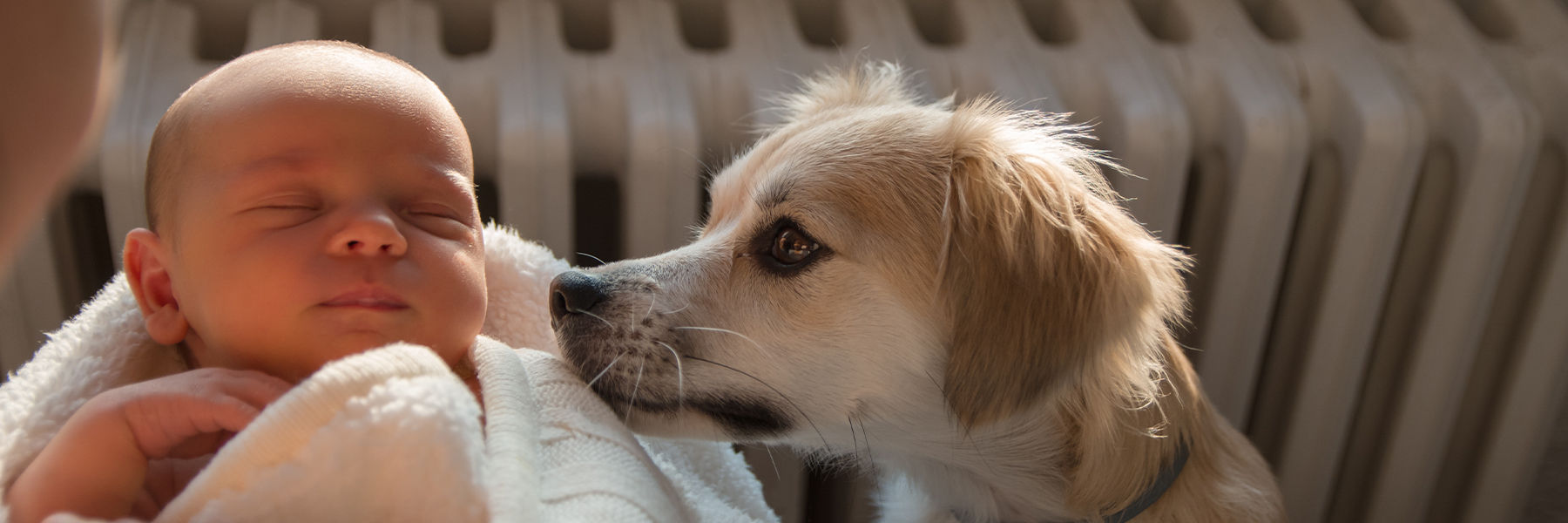Use arrow keys to navigate through the menu items. Use Tab key to navigate through the menu banners.
Pets And Your Newborn

Pets And Your Newborn
The arrival of a human sibling is a big change in your fur baby’s life – here’s how to get things off to a great start
Bringing your baby home for the first time is a moment you’ll never forget. But if you have a pet, you may feel a little apprehensive about how they’ll react to your newest family member.
We’ve asked two experts for their tips to smooth the transition. Vet Dr Michael Lazaris (@drlazaris_vet) is founder of Vets on the Common, and Daniel Warren-Cummings is central behaviour officer at the charity Cats Protection (@catsprotection).
With their advice, you can help to minimise stress for your pet and encourage a bond between your babies – both human and furry!
First meeting: your baby and your dog
-
Make sure your dog has been on a long walk and has rested for an hour or two so they’re nice and relaxed.
-
Let them sniff a blanket or item of clothing that your baby has had in hospital to get them used to the smell before they meet baby.
-
Sit down in a quiet room with your baby in your arms. ‘Don’t pay too much attention to your dog, as you don’t want them getting over-excited,’ says Michael. ‘If they do, leave the room and try again later.’
-
Follow your instincts – you may prefer a brief interaction or feel comfortable with a longer introduction.
-
Your dog might sniff your baby, which you should praise as being gentle. ‘Don’t force them to interact with your newborn,’ explains Michael. ‘If they seem stressed or uninterested, try again the next day.’
First meeting: your baby and your cat
-
‘If possible, get a pheromone-based diffuser and make sure it’s switched on at least 24 hours before baby arrives home,’ suggests Daniel. ‘This will gently soothe your cat and help relieve any anxiety or stress.’
-
For the introduction, sit in a room that your cat is comfortable in, with baby in your arms. ‘Make sure the space has enough hiding places for your cat, should they feel anxious,’ explains Daniel.
-
Allow your cat to investigate and sniff at their own pace. Don’t pick them up and bring them to your baby or present your baby to your cat’s face.
-
Your cat may be curious straight away or take some time – it can be a gradual process.

Parent talk
Here’s how other new mums and dads handled the introduction.
‘We sent home a babygrow for our dog, Hugo, to sniff when we were in hospital with our newborn, Isabella. When we got home, we went to see Hugo to get all his excitement out. Once he was calm, we brought Isabella in and let him sniff her a few times. We gave him a treat for being such a good boy.’
Olivia Tarn, mum to Isabella, 4 weeks
‘Once we got home and settled in with our new baby, Alfie, we asked our dog walker to bring Simba back. Greeting him in our usual way, we let him smell Alfie’s hat from the hospital. Then we introduced him to Alfie without holding his collar, so that he wasn’t nervous. Simba kept coming back to sniff Alfie, it was really sweet.’
Samantha Bloch, mum to Alfie, 2
‘We got home with our newborn, Jack, and then collected our cat Winston from the cattery. My husband held Jack in his arms on the floor and let Winston come right up to him. Winston gently rubbed his face on Jack, and they’ve been best friends ever since.’
Laura Welka, mum to Jack, 2
Getting used to baby
Baby’s arrival in the home can make pets anxious. You may notice your dog starts to show destructive behaviour, such as destroying toys or furniture, constantly barking or toileting indoors.
It’s normal to give most of your attention to your baby at this stage, but it can lead to dog jealousy such as barking, avoidance and begging. Remember to use praise and treats for good behaviour to help build your dog’s confidence and include them when you go on walks with the pram.
‘You’ll know how your cat is feeling by their tail position,’ says Daniel. ‘It will be upright when they’re happy and at a lower-mid level position when they’re uncomfortable. Other signs of stress include hiding, avoidance, and over-grooming.’
It can take a matter of days or weeks for your pet to get used to your baby but having a ‘safe space’ for them to relax in will help. Choose a quiet room and make a cosy area with their favourite toys and comfort items – the perfect spot for them to unwind in as they adapt to their new lifestyle.
Nurturing a safe and positive relationship
During your early days as a little family, keep a close eye on your pet and baby so that you can prevent any unwanted behaviour, including over-enthusiastic sniffing or licking. It’s best to err on the side of caution.
You could install a stairgate to prevent your dog going upstairs to baby’s room and keep the door to baby’s bedroom shut. Your baby’s crib, with its inviting, elevated space and warmth, may attract your cat. ‘We advise that cats are kept out of rooms with cots or where the baby is sleeping, as this is a serious safety risk,’ says Daniel.
‘Once you’re happy that your pet is comfortable around your baby, dedicate time daily for them to be close to your baby, with an adult present, of course,’ says Michael. ‘One-on-one time for you and your pet is also important to reduce any jealousy.’
As baby grows
Once your little one starts rolling over, crawling, and moving, it will be time to teach them proper animal etiquette, so that they can interact and play safely with your pet. For now, rest assured that you’ve laid the foundations for a truly special friendship.
Help & Customer service
- Help Centre
- How to shop
- Product recalls
Payment Methodslist with 8 items
- Asda Group of Companies
- Modern Slavery Statement
- Electrical Waste Recycling
- Terms & Conditions
- Customer Review Policy
- Privacy Centre
- Cookie Settings
- Accessibility
© ASDA 2025